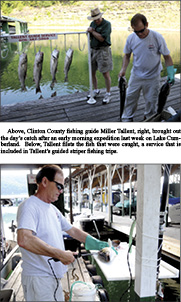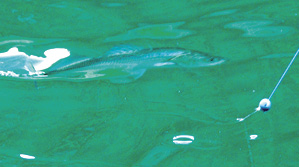New size limits for striped bass should benefit species and fishing
Clinton County has an abundance of luxuries within it’s borders, including two of the largest man-made lakes east of the Mississippi River.
One of those treasures is Lake Cumberland, the only one of our two lakes that has striped bass in its waters.
This year, Kentucky Department of Fish and Wildlife officials have dropped the size limit on stripers from 24 inches to 22 inches.
Local fisherman and guide service operator Miller Tallent said there is a really good crop of fish that range from 22-23 inches.
“If we catch these 22-23 inch fish, by the rule from the KDFW, we can keep them on and not keep on fishing. We can limit out quicker. They will keep fishing until they catch their limit. It saves us fish in the long run.”
Tallent said stripers have to have 60 degree water in the summer and two to three parts per million of oxygen in order to survive.
“It’s going to help things out,” Tallent said. “The last five or six years or so, with the water being down at the elevation of 680 feet, that has caused the lake to have an abnormal temperature.”
Construction work repairing leaks at Wolf Creek Dam is nearly complete. The U.S. Army Corps of Engineers estimates the work will be completed by December 2013. If the schedule is met, the lake could return to normal summer water levels for the 2014 recreation season.
The biggest concern with the water temperature is the higher the temperature, the lower the amount of oxygen in the water.
“By doing this, its going to help keep our bigger fish in the lake,” Tallent said. “They will get a chance to grow bigger instead of catching and releasing and have a chance that some of them die.”
The reason for the warmer water is due to the fact that when water is pulled through Wolf Creek Dam from Lake Cumberland, it is pulled the cold, oxygenated water off of the bottom.
“The year before last we had all those big rains and if Lake Cumberland comes up fifty feet, higher than 680-foot elevation, they have to pull off 50 feet of the bottom cold water,” Tallent said. “That’s where it kills you. The fish will always go deeper during the summer months. Most years I will catch fish 80 feet deep in August and September and that’s almost unbelievable.”
This year has been one of the best years as far as water is concerned because there has not been a lot of rainfall according to Tallent.
“Since we had that fish kill two years ago, we don’t have as many big fish as we use to have,” Tallent said. “When you catch and release, most of those fish under the size limit die. That’s the problem and that’s the reason we are going to 22 inches. When you catch those fish and bring them up to 80 degree water, they will become lethargic and they will sit on top of the water. They will try to swim off, but they are weak.”
Tallent, who has operated Tallent Guide Service for several years, says that the fishing activity is at a good level right now as far as business is concerned.
During the past several months, Tallent has been booked solid, fishing five days a week.
“We’ve limited out about every trip for the past month or two,” Tallent said.
Not having an abundance of stripers in Lake Cumberland not only hurts the guides, it plays a big part in the local economy as well.
“People don’t realize the effect on our economy that striper fishing has, along with the marinas,” Tallent said. “I’ve took people during the last two weeks from New York, Nebraska, Ohio, Indiana and local people from Clinton County. When they come down, they spend money. When they come down they always ask about places to eat, they will get gas … The people on houseboats have people like John Roberts and David Claywell down all the time to work on air conditioners. That helps us in a lot of ways. You will find out if you ask the tourists that most of them are coming to the lakes.”
Department officials decided to reduce the size limit on striped bass so that anglers could have the opportunity to keep some fish that might die anyway.
“If you are going to lose the fish, then we prefer that people get some use out of them,” Jeff Ross assistant director of fisheries for the Kentucky Department of Fish and Wildlife Resources said. “We are trying to make the best of a bad situation.”
Ross is confident Lake Cumberland will resume its place as the best striped bass fishery in Kentucky after work on the dam is finished and water levels return to normal. “After the water comes back, we expect the striped bass to rebound quickly,” Ross said. “We are still stocking. When we get the optimal water conditions back, the striped bass will thrive.”
“The fight stresses the fish in the cooler months, but higher water temperatures in summer are really rough on striped bass,” Ross said.
Biologists will continue to monitor the striped bass population after the lake returns to normal levels. The minimum size limit can be readjusted if needed.
The daily creel limit of two striped bass remains the same.

Miller Tallent uses a net to snag fish in order to keep them from getting off the line during his fishing trips. Dean Danison from Columbis, Ohio, poses for a photo of a fish he caught on Monday, June 25, 2012.


Striped bass prefer colder water and during the summer months, can be found beyond 30 feet deep in Lake Cumberland. The daily creel limit on stripers is two per person.

Miller Tallent, local striper guide on Lake Cumberland, starts his day way before his clients do when they come to fish. He is shown above working on leader lines around 4:30 a.m., just before his clients arrive. Tallent said he spends one day a week catching bait, which is done around 1 a.m.



